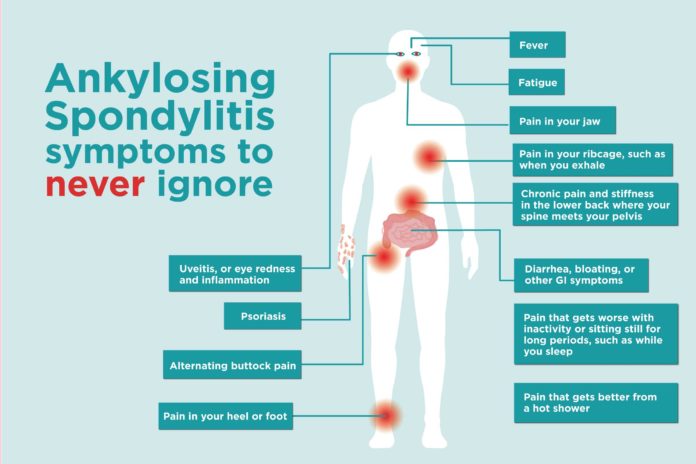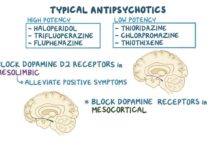Ankylosing spondylitis is a form of chronic inflammatory arthritis that primarily affects the joints, ligaments, and tendons of the spine. Specifically, ankylosing spondylitis causes enthesitis — inflammation where the tendons, ligaments, and bones meet.
A hallmark of ankylosing spondylitis is inflammation of the sacroiliac joint, the joint between the sacrum, which is the bony structure at the base of the spine, and the bones of the pelvis.
In advanced cases, ankylosing spondylitis can cause new bone to grow in the inflamed areas and the vertebrae of the spine to fuse together.
This can lead to kyphosis, a type of spinal curvature that results in a forward-hunching posture.
Signs and Symptoms of Ankylosing Spondylitis
The most common symptom of ankylosing spondylitis is low back pain that develops so gradually that it may go unnoticed in the early stages.
Other signs and symptoms of ankylosing spondylitis include:
- Fatigue
- Stiffness that is worse in the morning
- Pain in the buttocks
- An improvement in pain and stiffness with physical activity
- Hunched posture
- Difficulty breathing deeply
Ankylosing spondylitis can also cause inflammation in other parts of the body, including the eyes, called uveitis, and the aortic valve and aorta, called aortitis.
Typically, symptoms worsen over time — gradually for some people and more rapidly for others.
Learn More About Signs and Symptoms of Ankylosing Spondylitis
What Does Ankylosing Spondylitis Feel Like?
People with ankylosing spondylitis often feel chronic pain, primarily in the spine, but sometimes also in other joints, including the:
- Heels
- Hips
- Ribs
- Shoulders
- Small joints of the hands and feet
The chronic pain is usually a result of the inflammation caused by AS and can vary from mild to severe. Some people with AS report having an overall sense of discomfort and stiffness all the time. (2)
AS causes back pain that is worse at night, with improvement upon arising. Some people experience worsening of back pain and awakening during the second half of the night in particular. There is usually improvement in pain and stiffness with exercise, but no improvement with rest. (3)
Many people with AS have buttock pain, which is indicative of inflammation of the sacroiliac (SI) joints. The SI joints are located at the base of the spine, where the spine meets the pelvis.
Neck pain is another possible symptom of the disease. Women with ankylosing spondylitis may have more neck and peripheral joint pain (pain in the knees, elbows, and ankles) and less spinal involvement than men. (4)
What Causes Ankylosing Spondylitis?
The precise underlying cause of ankylosing spondylitis is unknown, but it is believed to have a strong genetic component, and possibly an environmental one.
Most individuals who have ankylosing spondylitis have a gene variation called HLA-B27.
For example, over 95 percent of Caucasians with ankylosing spondylitis have the HLA-B27 gene variation, while about 50 percent of African Americans with ankylosing spondylitis have it, according to the Spondylitis Association of America.
Populations with a low frequency of the HLA-B27 gene variant have a correspondingly low occurrence of ankylosing spondylitis.
But most people with HLA-B27 do not develop ankylosing spondylitis, and it is not known how HLA-B27 increases the risk of developing it. (5)
Little is known about the environmental factors that trigger ankylosing spondylitis. Some researchers believe that bacterial infections may be a factor.
Is Ankylosing Spondylitis an Autoimmune Disease?
Whatever its trigger, ankylosing spondylitis is an “immune-mediated” disease, which means it results from abnormal activity of the body’s immune system. Immunologists disagree about whether it is an autoimmune disease.
In autoimmune diseases, the body mistakenly attacks a substance, called an antigen, that’s produced by the body. The blood proteins that attack the antigen are called autoantibodies, and they are detectable in a blood sample.
But autoantibodies are seldom found in people with ankylosing spondylitis, according to James T. Rosenbaum, MD, writing for the Spondylitis Association of America.
In recent years, scientists have begun to use the term “auto-inflammatory” to refer to inherited diseases that cause repeated episodes of inflammation in the absence of autoantibodies. In these diseases, it appears the immune system is reacting to something other than a self-antigen.
But because ankylosing spondylitis has some autoimmune characteristics and some auto-inflammatory characteristics, many experts believe it falls into both of these categories simultaneously.
Diagnosing Ankylosing Spondylitis
There's no single diagnostic test for ankylosing spondylitis. If your symptoms and medical history suggest you may have it, your doctor will likely do the following:
- Conduct a physical exam, including an exam of your spine and rib cage
- Order X-rays and possibly other imaging tests to look for bone or joint changes
- Order blood tests to look for inflammation and to rule out other forms of arthritis
Can Ankylosing Spondylitis Be Mistaken for Fibromyalgia?
People with AS may be misdiagnosed with fibromyalgia, a chronic condition defined by pain and tenderness throughout the body that is often also associated with fatigue, anxiety, depression, sleep disturbances, and problems with memory or concentration.
But the pain of fibromyalgia is not associated with tissue inflammation the way AS pain is. Additionally, a key feature of fibromyalgia is that the pain and other symptoms are not explained by another rheumatic or systemic disorder.
Nonetheless, the results of a survey reported in the June 2019 issue of the journal Rheumatology and Therapy found that diagnosis delays and misdiagnoses are common among people with AS, and for women, especially, fibromyalgia is among the fairly common misdiagnoses. (6)
That being said, some people with AS also have fibromyalgia. A study published in Pain Physician in November 2019 found that one-third of patients with axial spondyloarthritis — a form of spondyloarthritis in which the predominant symptom is back pain — also have fibromyalgia syndrome. (7)
It’s also been found that coexisting fibromyalgia in adults with inflammatory arthritis, including AS, tends to worsen the arthritis disease activity. (8)
Duration of Ankylosing Spondylitis
Ankylosing spondylitis is a chronic disease that lasts a lifetime. But the effects of the disease and severity of symptoms vary from person to person. Some people have mild disease, with few symptoms, while others have chronic pain and stiffness that progress over time.
Effective treatment of ankylosing spondylitis can ease pain and stiffness, preserve physical functioning, and maximize quality of life. In some cases, treatment results in disease remission, meaning a person’s AS symptoms have little or no impact on their daily living, and their lab tests show low or no evidence of inflammation.
Complications of Ankylosing Spondylitis
Osteopenia and osteoporosis — both terms for low bone mass, or low bone mineral density — are common complications of ankylosing spondylitis, and both raise the risk of spinal fractures.
While lack of physical activity may contribute to low bone mass later in the disease, a study published in July 2015 in the journal RMD Open concluded that inflammation plays a key role in bone loss in ankylosing spondylitis. (9)
Other potential complications of ankylosing spondylitis include:
- Aortitis
- Aortic valve disease
- Disturbances in the heart’s electrical impulses
- Weakened heart muscles
- Reduced blood flow to the heart
- Fibrosis, or scarring, of the upper lobes of the lungs
- Breathing impairment due to chest wall restriction
- Sleep apnea
- Spontaneous pneumothorax (collapsed lung)
- Uveitis
How Ankylosing Spondylitis Causes Aortic Regurgitation
Some people with AS develop chronic inflammation at the base of the heart, around the aortic valve, and at the origin of the aorta, the main artery that carries blood away from the heart.
Years of chronic inflammation can lead to aortic regurgitation, a condition that occurs when the aortic valve doesn't close properly, causing blood to flow backward.
According to the American Heart Association, over time, untreated aortic regurgitation can lead to congestive heart failure, or severe failure of the heart to function properly.
A study published in November 2015 in the American Journal of Medicine reported aortic regurgitation may cause symptoms such as dyspnea — uncomfortable or labored breathing — as well as reduced physical capacity and fatigue that might be wrongly interpreted as symptoms related to a person’s ankylosing spondylitis, not to heart problems. (10)
In this particular study, aortic regurgitation was found in 18 percent of the participants with ankylosing spondylitis. In addition, aortic regurgitation was associated with both age and severity of ankylosing spondylitis.
The researchers suggest that routine care in ankylosing spondylitis include monitoring with both echocardiography and electrocardiography. Once diagnosed, symptomatic aortic regurgitation can be treated with medication or by surgical repair or replacement.
Can Ankylosing Spondylitis Cause Costochondritis?
Costochondritis is a condition that causes pain and tenderness in the chest. The pain happens in an area called the costosternal joints, where the ribs meet the breastbone.
In people with AS, pain in the thoracic spine and around the chest wall is common and is a result of the inflammatory disease. People often have pain in the sternum, costosternal areas, and sternoclavicular joints. Because of the inflammation, there may be inadequate chest expansion. This finding is common enough that it’s included in criteria for ankylosing spondylitis. (11)
Ankylosing Spondylitis Progression
Ankylosing spondylitis is a progressive disease. People with AS may initially have pain in the lower back, sacroiliac joints, or buttocks area that progresses to other areas, including the hips, shoulders, or neck.
For some, if the disease goes untreated, the inflammation may cause the spine to fuse. According to the Mayo Clinic, this fusing makes the spine less flexible, resulting in a hunched-forward posture.
While knowledge is limited on the triggers of AS progression, researchers believe the following predictors are involved: (12)
- Exposure to bisphosphonates, a type of osteoporosis treatment, in women
- High C-reactive protein levels, an indicator of inflammation, in men
- Obesity in men and women
- Smoking in men
Conditions Related to Ankylosing Spondylitis
Ankylosing spondylitis is one of a group of inflammatory rheumatic diseases known as spondylitis, spondyloarthropathy, or axial spondyloarthritis.
Other forms of spondylitis include nonradiographic axial spondylarthritis (nr-axSpA), a condition characterized by back pain and other symptoms but no visible evidence of chronic inflammation on X-ray. In some cases, nr-axSpA later becomes ankylosing spondylitis.
Inflammatory back pain is another condition that causes back and buttock pain, similar to ankylosing spondylitis. It may or may not progress to another form of spondyloarthritis.
About 10 percent of people with ankylosing spondylitis also have a form of inflammatory bowel disease, according to the Spondylitis Association of America. Inflammatory bowel disease includes both Crohn’s disease and ulcerative colitis.
People with ankylosing spondylitis have an elevated risk of developing AA amyloidosis, a rare disease in which abnormal proteins build up in the body. In AA amyloidosis, specifically, the buildup of amyloid proteins tends to occur in the kidneys. Anti-inflammatory treatments including TNF alpha blockers and interleukin-1 (IL-1) inhibitors have been shown to suppress blood levels of the proteins that lead to AA amyloidosis. (14)
Does Ankylosing Spondylitis Raise the Risk of Cancer?
Decades ago, ankylosing spondylitis was treated with radiation (X-rays) to reduce inflammation in the spine. While the treatment had its desired effect, it also increased the risk of leukemia and aplastic anemia later in life.
While radiotherapy has since been replaced by drug therapy in the treatment of ankylosing spondylitis, researchers have continued to investigate whether modern treatments, or the disease itself, may be associated with a higher risk of cancer.
So far, study results have been mixed.
At least two studies using data from national Swedish registers have found no increased risk of cancer among people with spondyloarthritis, according to a review published in March 2018 in the journal Frontiers in Medicine. (15)
A study of Taiwanese individuals diagnosed with ankylosing spondylitis between 2000 and 2008 found a higher incidence of prostate and bone cancers in men, colon cancer in women, and blood cancers in both sexes. The study, published in August 2017 in the journal Oncology Letters, also found that people with ankylosing spondylitis tended to develop cancer earlier in life than those who don’t have the inflammatory disease. (16)
Another study, presented at the American College of Rheumatology 2018 annual meeting, found a higher risk of certain cancers — and a lower risk of other cancers — among U.S. Medicare beneficiaries age 65 or older with ankylosing spondylitis. The researchers concluded that it was unclear whether the cancer risks were associated with the disease or the treatment for the disease in this population. (17)
Resources We Love
Favorite Patient Advocacy Organizations
Arthritis Foundation
From the leading patient arthritis organization, learn what you need to know to live well with ankylosing spondylitis.
CreakyJoints
This online patient community presents straightforward information on ankylosing spondylitis symptoms as well as opportunities to learn, connect, and advocate with others living with all forms of arthritis.
International Foundation for Autoimmune & Autoinflammatory Arthritis
A nonprofit patient advocacy organization focused specifically on autoimmune and auto-inflammatory diseases with arthritis as a main component of the disease, the IFAA works to raise awareness and advance research on these conditions.
National Ankylosing Spondylitis Society
For United Kingdom residents with ankylosing spondylitis, this is the place to turn for information and support.
Spondylitis Association of America
U.S. residents with ankylosing spondylitis can find information, message boards, and support groups here, as well as webinars and in-person seminars.
Reliable Sources of Ankylosing Spondylitis Information
American College of Rheumatology
Learn the basics on spondyloarthritis, a family of inflammatory rheumatic diseases that include ankylosing spondylitis, from this professional rheumatology organization.
Arthritis National Research Foundation
Keep on top of ankylosing spondylitis research by subscribing to the newsletter.
Hospital for Special Surgery
A leading orthopedic hospital, HSS publishes patient information articles on topics related to ankylosing spondylitis and other causes of lower back pain.
Mayo Clinic
This trusted source of medical information offers the basics on ankylosing spondylitis, including what to ask your doctor about your condition and its treatment.
Best App for People With Arthritis
ArthritisPower
ArthritisPower is a mobile and desktop app that allows individuals with arthritis to track, measure, and share their symptoms and treatment outcomes while simultaneously participating in arthritis research. It was created by CreakyJoints (see above) in collaboration with the University of Alabama at Birmingham and supported by a grant from the National Patient-Centered Clinical Research Network (PCORnet).
Diet Advice You Can Trust
Harvard T.H. Chan School of Public Health Nutrition Source
This trusted source of nutrition information can help you choose what to eat for strong bones and explain what makes a good choice good.
Everything You Need to Know About Lab Tests
LabTestsOnline
Wondering what that lab test is measuring or what the results mean? This is the place to learn what blood and imaging tests may be done for ankylosing spondylitis.


Editorial Sources and Fact-Checking
- Van der Horst-Bruinsma IE. Spondyloarthritis: New Names for Old Acquaintances. Nederlands Tijdschrift Voor Geneeskunde. 2014.
- How Is a Person Affected? Spondylitis Association of America.
- Rudwaleit M, Metter A, et al. Inflammatory Back Pain in Ankylosing Spondylitis: A Reassessment of the Clinical History for Application as Classification and Diagnostic Criteria. Arthritis and Rheumatism. February 2006.
- Roussou E, Sultana S. Spondyloarthritis in Women: Differences in Disease Onset, Clinical Presentation, and Bath Ankylosing Spondylitis Disease Activity and Functional Indices (BASDAI and BASFI) Between Men and Women With Spondyloarthritides. Clinical Rheumatology. January 2011.
- Diagnosing of Ankylosing Spondylitis. Spondylitis Association of America.
- Ogdie A, Nowell WB, et al. Real-World Patient Experience on the Path to Diagnosis of Ankylosing Spondylitis. Rheumatology and Therapy. June 2019.
- Rencber N, Saglam G, et al. Presence of Fibromyalgia Syndrome and Its Relationship With Clinical Parameters in Patients With Axial Spondyloarthritis. Pain Physician. November 2019.
- Duffield SJ, Miller N, et al. Concomitant Fibromyalgia Complicating Chronic Inflammatory Arthritis: A Systematic Review and Meta-Analysis. Rheumatology. August 2018.
- Briot K, Roux C. Inflammation, Bone Loss, and Fracture Risk in Spondyloarthritis. RMD Open. July 2015.
- Klingberg E, Sveälv BG, et al. Aortic Regurgitation Is Common in Ankylosing Spondylitis: Time for Routine Echocardiography Evaluation? American Journal of Medicine. November 2015.
- Wendling D, Prati C, et al. Anterior Chest Wall Pain in Recent Inflammatory Back Pain Suggestive of Spondyloarthritis. Data From the DESIR Cohort. Journal of Rheumatology. July 2013.
- Deminger A, Klingberg E, et al. A Five-Year Prospective Study of Spinal Radiographic Progression and Its Predictors in Men and Women With Ankylosing Spondylitis. Arthritis Research & Therapy. August 2018.
- Reveille JD, Witter JP, Weisman MH. Prevalence of Axial Spondylarthritis in the United States: Estimates From a Cross-Sectional Survey. Arthritis Care and Research (Hoboken). June 2012.
- Nienhuis HLA, Bijzet J, Hazenberg BPC. The Prevalence and Management of Systemic Amyloidosis in Western Countries. Kidney Diseases. April 2016.
- Moltó A, Nikiphorou E. Comorbidities in Spondyloarthritis. Frontiers in Medicine: Rheumatology. March 2018.
- Chang CC, Chang CW, et al. Ankylosing Spondylitis and the Risk of Cancer. Oncology Letters. August 2017.
- Alehashemi S, Ward M. Cancer Risk in Ankylosing Spondylitis in United States Medicare Beneficiaries: Detection of a Chronic Nonsteroidal Anti-Inflammatory Drug Use Signature. 2018 ACR/ARHP Annual Meeting. October 2018.
- Foods That Fight Inflammation. Harvard Women’s Health Watch. November 7, 2018.











































